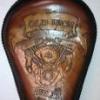
Ken Kent
Contributing Member-
Content Count
9 -
Joined
-
Last visited
About Ken Kent
-
Rank
New Member
Contact Methods
-
Website URL
http://N/A
Profile Information
-
Location
N/A
-
Interests
Floral carveing holster makeing...Target shooting single action revolver.
LW Info
-
Leatherwork Specialty
saddlemaker
-
Interested in learning about
all aspects leatherworking
-
How did you find leatherworker.net?
wickett&craig site
Recent Profile Visitors
1,250 profile views
-
I use clinch tacks on a regular basis building saddles & harness repair.I use them to hold 2 pcs of leather together that doesn't need to be glued before stitching.In the harness making industry contact cement doesn't stick to harness leather because the leather has waxes & oil infused into it at the tannery so clinch tacks hold the pieces together sometimes they are driven all the way in making the clinch & become part of the fastening system .Temporary clinch tacks I will sometimes put in the stitch groove & pull them out as i sew up to them the thread covers the hole.There are tube rivets that are made solid except a portion at the end which is hollow that will roll over & capture the material at the bottom eg tin bound stirrups.I'm thinking this might be in your case these rivets are made from steel,brass,copper,aluminum so on & so forth.I don't know a supplier but I do know Weaver uses them on their tin bound stirrups as I've used them on lower end saddles.Hope this helps you out not examining the sheath its only a guessing game.How I use the clinch tacks is I put a piece of steel under the work & that will turn back the end forming the clinch. Cheers, Ken
-
Ken Kent started following Straight stitches slightly slanted, Recreating the sheath for an historic knife, Rifle/Shotgun Case liner and and 2 others
-
The shot of the rivet at the tip looks like what's left of a tube rivet.What I think, leathersmyth is talking about are clinch tacks.They are cut to turn back on themselves into the leather and they make the J.The surface area in the photo is to large for clinch tacks.Can't really tell just a guess. Took another look at the one at the tip sure looks like a tube rivet.
-
Rifle/Shotgun Case liner
Ken Kent replied to txclas's topic in Gun Holsters, Rifle Slings and Knife Sheathes
These are the key ingredients in chrome tan.....Chromium Sulphate......Magnesium Oxide had to learn this stuff to pass the Saddlemaker leatherworker course I took in /99,this may help anyone who might be interested. Cheers Ken -
Rifle/Shotgun Case liner
Ken Kent replied to txclas's topic in Gun Holsters, Rifle Slings and Knife Sheathes
Not going to beat a dead horse I read the part about chrome tan causing rust as a reason to not to use it for liners,I simply said it does not cause rust it eats at the blueing a chemical reaction to the chrome tanning solution.I got this info from a saddlemaker who has 30 years more than my 20 years as a saddlemaker & leatherworker. Regards , Ken -
Rifle/Shotgun Case liner
Ken Kent replied to txclas's topic in Gun Holsters, Rifle Slings and Knife Sheathes
It will take the blueing off it's not about rust.You need moisture & oxygen to create rust.Chrome tanning is a chemical process, even a re tan latigo should not be used for a scabbard if the the rifle will be stored in the scabbard for a extended period of time. -
Used to buy from Weaver bought their leather splitter a few years ago by the time all was said & done $2500.00.Today went to Tandy for a few what I consider staple products,glycerine bar carnuba wax & beeswax I only got the bees wax.At this point I had to unload on the manager every time I go this is what I get discontinued discon....discon they really don't care about customer relations.When they opened the store in Edmonton it was like a dream come true they have been discontinuing ever since then.It's a 40 min.drive from my place to Tandy.I guess in reality this is now the norm.
-
whatever works I use a Henley.....Barry King.....Tandy.The better the steel the longer the edge lasts Ken
-
I had the same problem even a sharp blade will drag I use a small piece of veg. tan with either white polishing compound or green & even red jewelers rouge rubbed in to make a strop polish your sharpened edge on this strop,you will be amazed.You will have to strop every time your blade starts to drag. Another trick that will help is turn your knife blade so the long side is parallel to the long side of the stone push & pull the length of the stone alternating sides to keep the bevel even,what this does is keep the scratches from the stone running in the same direction as the cut. When you push the blade up & down the stone the stone marks are 90 degrees to the cut.The polish system works best for me I very seldom have to use the stone or diamond hone I sometimes use.Hope this helps. Regards Ken
-
I use 794s in my juki 441.The reason for the LR needle is that the slanted perforations make for a sturdier stitch line than if the perf.are all in a straight line.I use the 794s because it has the eye appeal that I like.It takes more force to tear the LR than the S.All that being said I haven't had any kickbacks on the S stitch.This is my first post so I hope this explains the slanted stitch
- 13 replies
-
- stitch
- sewing machine
-
(and 3 more)
Tagged with:




